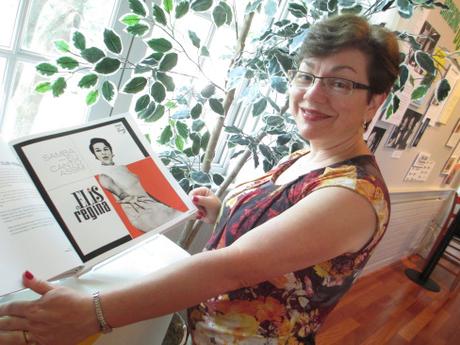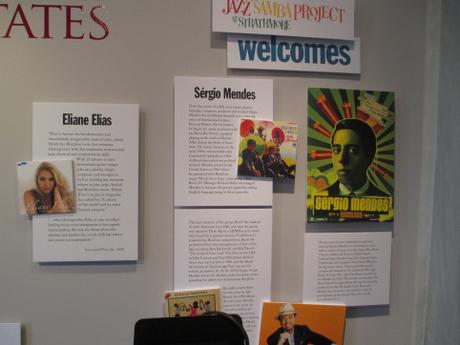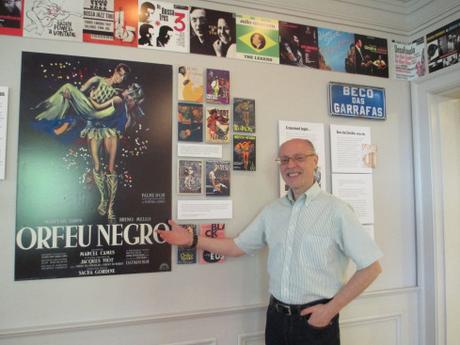Of Concerts and Symposiums
 The Felix E. Grant “Wall of Fame” at the Strathmore, June 8, 2014
The Felix E. Grant “Wall of Fame” at the Strathmore, June 8, 2014
What’s old is new. And what’s new gets old fast.
This was the takeaway from my visit in June 2014 to the Strathmore Music and Arts Center in North Bethesda, Maryland. As part of their week-long celebration, “Bringing Bossa Nova to the United States,” and in honor of the 50th anniversary of the landmark Verve album Jazz Samba recorded by Stan Getz and the Charlie Byrd Trio, I was invited to take part in the Jazz Samba Legacy Symposium on Saturday, June 7, 2014.
Among the featured events that week was the world premiere rough-cut screening of the documentary Bossa Nova — the Brazilian Music that Charmed the World, directed and produced by videographer Bret Primack and co-produced by music journalist, educator, guitarist, and bandleader Ken Avis, along with a Q & A session with Buddy Deppenschmidt, who played on the classic Jazz Samba. I had the immense pleasure of meeting and interviewing the famed jazz drummer, performer, and teacher on Sunday, June 8, 2014, at the Strathmore Music Center’s Education Room 309, which I have previously written about and posted (see the following link: https://josmarlopes.wordpress.com/2015/12/28/its-jazz-samba-time-celebrating-the-50th-anniversary-of-the-landmark-bossa-nova-album/)
Prior to our interview, my wife Regina and I took an extensive tour of the Jazz Samba Project Exhibit, co-curated by Georgina Javor, the Strathmore’s former Director of Programming, and the aforementioned Mr. Avis. The exhibit showed only a small fraction of the extensive Felix E. Grant Jazz Archives, at the University of the District of Columbia, which was itself curated by Dr. Judith A. Korey, Professor of Music, whom I also met and spoke to.
Felix E. Grant was a local Washington, D.C. radio broadcaster who took a personal interest in bringing jazz and Brazil’s music and culture to American shores. It was a fabulous exhibit! We were extremely pleased with its breadth and scope, in particular the “walls of sound” (my term) wherein album covers of well known and obscure recordings from the late 1950s up through the mid-60s were displayed up-and-down and across the room’s walls. We had some truly memorable moments re-visiting and re-connecting with bossa nova greats (and not-so-greats) from years past. The entire display reflected a high degree of professionalism and respect for Brazilian music — a most satisfying experience for us.
One of the highlights was a prominently showcased, generously proportioned coffee-table tome (a copy of which I subsequently ordered online) entitled Bossa Nova and the Rise of Brazilian Music in the 1960s, and from which the above exhibition was drawn.

Published in 2010 by Soul Jazz Books, a division of Soul Jazz Records, this hardcover volume is a collection of bossa nova record album cover art work from the Odeon, Elenco, Philips, and other labels from the period in question. It was compiled by Gilles Peterson, a British-based DJ, record collector, and record label owner, and Stuart Baker, the founder and proprietor of the Soul Jazz label.
Between its covers were featured breathtakingly beautiful modernist and revolutionary designs (some hinting at the coming “psychedelic” era) that reflected “the radical and exciting idealism of Brazil at the start of the 1960s,” an idealism that was quickly squashed with the advent of the military dictatorship post-1964 and the subsequent crackdown of 1968.
The fading memory of those bitter times and my fellow Brazilians’ nearly two-decade long struggle to free themselves from the generals’ iron grip have left some young people — and a growing number of old-timers with faulty recollections — with an alarming nostalgia for “the way things were.” This self-deluded yearning for the purported “good old days,” where Ordem e Progresso (“Order and Progress”) — curiously, the country’s motto stamped on the Brazilian flag — remains an unrealized promise, will serve as an excellent example of our penchant for hankering after a non-existent past.
My observation above of things that are old being new and those that are new getting old stems as well from a Friday evening concert of June 6, 2014, by Brazilian pianist Eliane Elias and the Grammy Award-winning Niteroi-born singer-musician Sérgio Mendes and his band. Both Sérgio and Eliane have long pedigrees in the pop-music business going back many decades.

In Eliane’s case, her piano playing craft on the night of the concert was anything but old. Quite the contrary, she displayed finger-snapping pep and vigor to burn on the old 88s. Her treatment of material by Jobim, Ary Barroso, and Ronaldo Bôscoli, in addition to some of her own compositions, was well-nigh perfect, with just the right amount of zing and pizzazz in all the right places. Eliane was helped by a crack band of first-rate players, consisting of husband Marc Johnson on upright bass and the carioca-born Rafael Barata on drums. Barata made a particularly spectacular impression with his lightning-fast solos and fancy stick-work — why, the man was a veritable human octopus!
The second half of the program, which starred Mendes on keyboards and vocals, and his wife Gracinha Leporace as soloist providing backup support, included toward the end a re-imagined “rap” version of Jorge Ben Jor’s signature “Mas Que Nada” tune — fine and dandy in execution, but hardly an audience favorite with the over-50 crowd that predominated — and a final encore of Mendes, John Powell, Carlinhos Brown, Mikael Mutti, and Siedah Garrett’s “Real in Rio” from their 2011 animated collaboration Rio (produced by Blue Sky Studios) that fell flat and virtually sucked the air out of the good vibes left over from “Mas Que Nada.”
Mixing the old with the new, then, turned out to not only to be a mixed bag but one that left a big, fat hole in an otherwise excellent program shared by two established Brazilian artists.
The Offer I Couldn’t Refuse
Before I get into the particulars of the Jazz Samba Legacy Symposium, let me recount what led up to my participation in that weekend invitational. It was Buddy Deppenschmidt himself who informed me about this event in Bethesda. He sent me the link back in mid-March 2014, which I swiftly checked out. As I did so, my wife called me to say that somebody from the Jazz Samba Fest had phoned my home asking for additional information. Now that was quick! My wife tried to get the name of the lady who called, but was unable to understand the semi-garbled message.
My initial thought, if indeed I’d ever get the rare opportunity to be up there with the Giants of Jazz Samba and Bossa Nova, was to discuss Black Orpheus (that is, the original play and musical), how it all came about, how the Vinicius de Moraes and Antonio Carlos Jobim partnership came together, and all that jazz. Might as well put my knowledge to good use, at least that was my impression, since I had been involved in trying to bring the project to Broadway for the last, what, six or more years!

Finally, I received an e-mail from Ms. Georgina Javor, the young lady who had called my home. She would love to have me attend some of the festivities and asked if I had ever moderated any discussions before? I told her that yes, I had moderated a few as well as interviewed several personalities in the recent past, and that I would love to moderate the Q & A session with Buddy.
Georgina spelled out the terms of my participation, to which I accepted. In addition, she kindly provided tickets to the Elias-Mendes Friday night concert, which for us turned out to be the spicy topping on this all-Brazilian pastry.
(To be continued…)
Copyright © 2016 by Josmar F. Lopes

